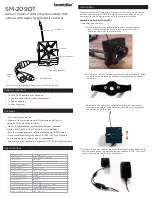INFICON
Specifications | 3
074-708-P16B D-TEK Stratus Operating Manual
7 / 405
2
Use in temperatures below 0°C (32°F) should be limited. Extended warm-up time is
recommended before use in low temperature environments.
Specification table in accordance with EN 14624
R134a
R1234yf
Minimum sensitivity, fixed (static)
1 g/yr.
0.5 g/yr.
Maximum sensitivity, fixed (static)
3
>50 g/yr.
>50 g/yr.
Minimum sensitivity, moving (dynamic)
1 g/yr.
1 g/yr.
Maximum sensitivity, moving (dynamic)
3
>50 g/yr.
>50 g/yr.
Minimum response/detection time
< 1 s
< 1 s
Zeroing time
1–4 s
1–4 s
Recovery time for 50 g/yr exposure
4
7.6 s
6.4 s
Minimum sensitivity in contaminated
environment
>2 g/yr.
1 g/yr.
Calibration frequency
Check annually with calibrated leak
standard
3
The upper leak detection limit is not specified by INFICON as there is no upper limit
to the size of the leak the detector is able to detect.
4
As no 50 g/yr. leak standard was available during testing, a 32 g/yr leak standard was
substituted.
SAE Applications
SAE standards J2791 (R-134a) and J2913 (R-1234yf) specify sensitivity to the
following leak sizes for the corresponding settings below. Super sensitivity is more
sensitive than what is required by SAE for leak checking in a clean environment (free
of background refrigerant). If leak checking in a contaminated environment (high
background refrigerant), switch to Super sensitivity.
R-134a leak rate (g/yr)
R-1234yf leak rate (g/yr)
Sensitivity Setting
14
14
low
7
7
medium
4
4
high
The following table lists some common under-hood chemicals and indicates whether
or not they will cause a false-trigger from D-TEK Stratus.
Chemical
False-Trigger
Windshield washer solvent (methanol base)
yes
Ford
®
spot and stain remover
yes
Ford rust penetrant and inhibitor
yes
Ford gasket and trim adhesive
yes
Permatex
®
natural blue cleaner and degreaser
yes
English
English


















